![interesni_kazki_interview12]()
Aleksei Bordusov aka AEC and Vladimir Manzhos aka Waone, better known as
Interesni Kazki, are an artist duo from Kiev, Ukraine. They've been taking the street art world by storm in the recent years with their colorful surrealistic large scale murals. Famous for their unusual and imaginative imagery, the wide range of characters, elements and symbols used, bright colors and smooth gradients, their works are now grace walls from India to Mexico, and from Miami to Moscow. After painting around Europe and Russia in the summer, they went on a three month trip to Central America and USA, taking part in different projects and creating more impressive public works. Recently they came back home, and we managed to get in touch with them between taking some much needed rest and preparing works for upcoming projects in Dec 2013 and the next year.
![interesni_kazki_interview16]() AM: Since when do you remember having interest in art, and when/why did you start painting in the street?
AM: Since when do you remember having interest in art, and when/why did you start painting in the street?
Waone: I have interest in art since I was I child, 4-5 years old. My father had interest in art and he collected Ukrainian art and rare icons. I started to paint graffiti when I found out about it at the end of 90s. I was impressed and started to try to do something like that immediately.
AM: When did you and Aleksei meet and how did you begin such a close collaboration?
Waone: We met in 1999 in a strange place. The place was where people who were interested in graffiti were meeting, talking, drawing sketches, etc.
AM: Do either of you have any formal education as artists?
Waone: I don't have any artistic education. But, I took some drawing and painting classes in my childhood. Most of my education comes from practice and feeling out how to do or not to do.
![interesni_kazki_interview13]() AM: I read in another interview that you two were actively doing graffiti before starting to paint murals. What made you switch to that and when did you the murals?
AM: I read in another interview that you two were actively doing graffiti before starting to paint murals. What made you switch to that and when did you the murals?
Waone: Yes, we were actively painting traditional letter graffiti for 3-4 years. "Hip-hop graffiti" means to paint letters and characters, and we painted both. Once we saw another type of graffiti, not traditional "hip-hop American stuff" (it was stuff from Brazil), we discovered for ourselves new horizons. We tried to paint walls without letters and liked it very much. So that time was the origin of our style. It was 2002-2003. In 2005, when the style was formed, we appeared under the name Interesni Kazki.
AM: What do you see as pros and cons about being an artist duo like Interesni Kazki?
Waone: It happens hardly ever that two artists work together. The main plus of working in a duo is the study. It's a big and fast progress. The minus of being an artist in duo is dependence on each other.
AEC: When we work together, it can give a more unexpected result of the whole finished work. Sometimes it's great but sometimes not, especially if one of us had an idea of the whole mural that was changed or became unclear when mural was done. In this case, I can say that painting together is more improvisation, more freestyle, even if we are trying to discuss sketches and work before starting. It's good to take breaks in collaborations, because each of us is an independent person with our own look to the way of creation and philosophy.
AM: What are your thoughts of the work of other duos such as How & Nosm or Os Gemeos?
AEC: I like the works of the guys you mentioned.
Waone: I respect them. I can't say that I like their work too much, though we have been influenced by Os Gemeos works in the past. But now, I think they stopped their progress. Unfortunately it happens with most of artists, when they became famous and rich.
![interesni_kazki_interview06]() AM: I read somewhere that your work feels like an Eastern European version of Os Gemeos. How do you feel about being compared to them?
AM: I read somewhere that your work feels like an Eastern European version of Os Gemeos. How do you feel about being compared to them?
Waone: Many people think that we work in a similar style as Os Gemeos. Some people says that we are similar to Salvador Dali or Hieronimus Bosch. For me, it doesn't matter. I respect all of them and take people's comparisons as a compliment.
AEC: Sometimes, I hear these comparisons of us and other artists, but I don't care much about it. It's normal and a lot of artists have some similar ideas or some kind of "universal" ideas or similar styles. Even me and my colleague Vladimir are working a bit different if you're looking at it closely. But at the first glance it all seems the same.
AM: You and Aleksei are both making your own works which is not typical for other collaborating duos. What is your philosophy behind doing separate works?
Waone: Our philosophy is very simple - to give each other freedom.
AEC: As I said before - each of us has our own view on life and own philosophy. For me, to work separately is the way to search for something different than our collaborative creations. Then, this experience can come in handy in our future collaboration because we always have to put something fresh in our collaborations or it can all collapse.
![interesni_kazki_interview10]() AM: You guys are traveling all over the world to paint. Do you try to create works that fit to the culture/surroundings you are painting in, and how do you work on that?
AM: You guys are traveling all over the world to paint. Do you try to create works that fit to the culture/surroundings you are painting in, and how do you work on that?
Waone: Sure, we do it almost every time. The thing is, when you come to any place, you get strong impression from local culture. So then you put all these impressions into the work. You are like a prism, subsuming all the local culture manifestations in your mind, than aggregating all that stuff into a masterpiece. It seems like the local spirit comes into your mind and comes out through your hands, paint, and brushes into the mural.
AEC: Surroundings can sometimes have impressive, bright elements, or nice cultural heritage, and sometimes strange and bad elements. These feelings will influence the inspiration.
AM: How long was your last trip in total, and how many murals did you create?
Waone: The travel took almost three months. In Ciudad del Carmen, Campeche Mexico we spent three weeks and were painting big mural during the two weeks. Then one week in Detroit. Than 1.5 months for a huge building in Wynwood, Miami. In total, we created two murals in Ciudad del Carmen and Detroit, three walls on the Wynwood House in the Wynwood district in Miami together with Alexei, and one big wall I did alone on the same building on Wynwood.
AEC: Yes, I just came back from that trip. In Cuidad del Carmen (Mexico), Detroit, and Miami, we painted together, but I also painted alone in Puerto Rico and Las Vegas. The whole trip took three months for me, and I feel a bit tired but happy.
![interesni_kazki_interview14]() AM: Your new Miami mural is pretty huge. How long did you work on that one?
AM: Your new Miami mural is pretty huge. How long did you work on that one?
Waone: For all four sides of that building, we spent 42 days in total.
AEC: Total time of painting in Miami was approximately 3-4 weeks, but a lot of time was wasted on not so good organization or waiting for the rain to stop. So, in total it was 34 days for me and Vladimir spent some more time in doing this wall. He also needed to stay longer because of private reasons. The amount of work was huge because we needed to paint all four walls of the building.
AM: How big is the wall and who helped you organize it?
Waone: The area of that building was more than 1000 sq meters. The organizers was the owner the building, Goldman Properties, and our assistant was Jel Martinez, a local artist.
AM: Did you create any canvas/paper works during this trip?
AEC: No, we didn't work on canvases or drawings during the trip, only sketches for murals that we worked on.
![interesni_kazki_interview07]() AM: Who should people contact about your canvases and works on paper?
AM: Who should people contact about your canvases and works on paper?
Waone: You can contact us directly, just write an email (waone_ik@yahoo.com), or write to our representative in NYC to gf@madeyoufamous.com (Gregory). Some pieces and prints will be available soon on
Underdogs too.
AM: What was the most favorite place you have visited!
AEC: My favorite place from this trip was Puerto Rico for the
Los Muros Hablan Festival. Thanks to my friend Alexis Diaz for inviting me!
Waone: I like many places. Can't pick out one of them. I like Mexico, but don't like their non-vegetarian food . I like the Azores Islands - amazing nature. I like India for their rich ancient culture, beautiful nature, and veggie food culture. I've just remembered about the Himalaya Mountains - it was fantastic. I think that place is my favorite.
AM: Is there a certain place in the world that you would like to paint, and why is that?
Waone: Every place becomes boring after spending some time there. It was great to paint in the US because of the perfect tools, very good paints, and huge art industry for example, but the US is the last place where I want to stay. The perfect place to stay and paint for me are the Himalaya Mountains. It's just my favorite place, it's really out of this world, it's another dimension. But the thing is that we came into this world not to rest in our favorite places.
AEC: I want to visit and paint in the countries of South America - Argentina, Peru, Chile, Ecuador, Brasil.
![interesni_kazki_interview05]() AM: What are your influences, and how do you feel about your work being compared to Dali and surrealists?
AM: What are your influences, and how do you feel about your work being compared to Dali and surrealists?
AEC: As I said, I don't really care about being compared to another artists especially if these comparisons are to huge and famous artists like Dali or Bosch. I think if somebody compares us to a very famous artist, it shows that this person knows very few artists (and only famous ones), or don't understand things completely. But also, it can be a compliment for us. I don’t think that our works are considered surrealism. It's more like some kind of symbolic metaphorism.
Waone: All the artists have influences. Artists grow up in his technique and as a person, so his interests are changing too. In childhood, I was influenced by children's books as well as scientific and fairy tale illustrations. Sure, I was inspired by Salvador Dali too, because my father had a book about him. When I started to paint graffiti, I was influenced by American "hip hop graffiti." Later, it was brazilian graffiti and Latin American muralists, drawings and book illustrations by Ivan Bilibin, Moebius etc. Now, I am passionate about naturalism - antique prints and mystic medieval engravings. I think we are a bit like Surrealists. As for me, Surrealism is a world view, like next level perception of the world, out of the normal physical senses. Surrealism is a kind of reality, imagined with symbols. It's like a dream, when subconscious or sometimes the "Higher Mind" tells you, through the images, symbols and colors, something very important about real life.
AM: I noticed that most of your murals all done with acrylic. Do you ever use other mediums for creating your work?
AEC: Yes, last year we worked on murals with acrylic only. I started to work with acrylic only in Mexico in May last year, and didn't feel like using spray ever since. Using brushes, rollers and acrylic gives more opportunities for creation and makes free from technologies. Also, it's not so bad your own health compared to the sprays that we used a lot of in the past.
![interesni_kazki_interview11]() AM: How different is it making smaller, gallery pieces compared to public murals?
AM: How different is it making smaller, gallery pieces compared to public murals?
Waone: It's totally different genres of art, but art is also the same in a way - same ideas, same feelings. I mean, when you paint, the stream of energy is flowing through your mind, and it doesn't matter if it is on wall or on canvas at all. This is the thing - street or gallery is secondary.
AEC: In the physical aspect, we spend less energy for creating studio works but not less time, but actually even more. For example - a huge wall can be done in 10 days, but a detailed drawing of 80x60cm size can take two weeks.
AM: Which one of the two would you say you prefer, and why?
AEC: Both are interesting for me and I love both. Traveling and painting murals gives a feeling of freedom and the experience creates a lot of emotions that gives a lot of inspiration. Later on, this inspiration can last for studio work too. Each of these two are connected and complement each other.
Waone: I prefer both.
AM: I saw a lot of locals closely following your work as you were creating the mural in Croatia (covered). Do you find it a pressure or a challenge to be watched so closely while you create?
AEC: It depend on the place and country we are working in. For example, when I painted in Moscow I felt pressure from people who passed by and stopped to say something - often something bad. But when I painted in India or in Mexico, I felt comfortable when local people talked to me on the street while painting.
Waone: Yes, sometimes locals disturb us, thats why we put up the barrier tape.
![24]() AM: How many gallery shows did you have so far, and how did you feel about having your work exhibited in a gallery?
AM: How many gallery shows did you have so far, and how did you feel about having your work exhibited in a gallery?
Waone: We had three solo shows and too many group shows. It's good promotion.
AEC: I feel ok to do a gallery show, but lately we were more focused on mural projects.
AM: A few months ago you had your first print release with Underdogs. How did you like working on that, and could you tell us a bit about the images you picked?
Waone: We likde that. It was a good experience. And, we will continue to work with them on prints. I don't know what to say about the picked images. We picked it together with Underdogs. My piece that we picked for print is
Triad - it's about the nature of the universe.
AEC: We enjoy the result - two digital prints of our recent canvases. But, the next release will be even better because it will be a screenprint with hand finishing in a very limited edition.
AM: In another interview, you mentioned the street art scene in Ukraine is not that big. Do you think your work is making it more popular, and do people in Ukraine know much about it?
Waone: Yes, the street art scene (not graffiti scene) in Ukraine is not big, and unfortunately there is no progress on it. Currently, there are bad conditions not only for street art but for life in general. People have to think how to survive, for them it's - "What street art are you talking about"?
AEC: I don't want to use the term "street art scene" because this seems like some kind of fashion statement. We have some very good artists in Ukraine, that sometime work on the street too. Yes, our works probably created more interest in art in the street, but we almost have not worked at all in public spaces in Ukraine in the last two years because of all the traveling and working on projects around the world. Ukrainians can see our new works only on the internet.
![Time Machine]() AM: How often do you paint back in Kiev, and what would you like to see happen to the art scene back there?
AM: How often do you paint back in Kiev, and what would you like to see happen to the art scene back there?
Waone: We used to paint a lot. We found an opportunity to paint as much as we could. The art scene can't change just because some powerful forces are interested in keeping it in this way - the way of human degradation. Not only in art scene, but nothing can change for the better when the worst people of society lead the country.
AEC: There was a time when we were trying to organize some mural projects in Ukraine, but we faced the wall of bureaucracy, difficulty in obtaining permits, and the inability to find financing. So, we decided not to waste our time and chose to participate in international mural projects to which we are often invited. But, we have not abandoned hope of success in this matter in Ukraine.
AM: How do you feel about your work being shared on the Internet so quick after it's finished, and do you like the way that is affecting the whole street art scene?
Waone: Sometimes, I think that it's nothing special and I don't care - I just care about doing my best.
AEC: I don't enjoy when work gets to the Internet very fast especially if it's not finished, or is of bad quality in terms of image / colors, or without my approval. But, I can't influence that because it's art in a public space. And, I don’t care much about the term "street art scene." Actually, I want to say something about it - There is tendency for a wave of popularity of street art in the world nowadays. Because of this, things that are made on the street often get more attention, respect, and are discussed by more people. As a result, they become more valuable than art that wasn't made on the street, but in reality, it is much more important and valuable. That is why I prefer to work with acrylic and brushes, more slowly, but with more quality, and try to use more diverse topics, imagery and details.
![DSC_0112]() AM: Do you read articles or forum posts about your works and how do you feel about it?
AM: Do you read articles or forum posts about your works and how do you feel about it?
AEC: Yes, sometime I see some nice text about our works and it can be interesting to read what people see in our works and how they understand it.
Waone: No, I don't. I don't have enough time for that. There are many other, more useful stuff to read.
AM: What are the major career goals for you two?
Waone: Five years ago, my goal was to travel and paint all over the world. Now I travel all over the world and paint. The last few years, we worked so hard and so often that I asked myself - do I need this? But each time after we finish, I see the viewers' reactions, how much they like what I do, and the big influence my work has in a good way. Then I understood - they need this. So my goal is just to do my best - this is the way to perfection. Perfection in art leads me to personal perfection, and this evolution. So the goal is evolution.
AEC: I think our painting is not a career but a way of life - the way to find reason in life and our own mission on Earth.
AM: Can you share with us what you have scheduled in the future? Any gallery shows or big projects planned?
AEC: We are taking part in group show in Lisbon with Underdogs this December, and in a group show in Miami during Art Basel with Greg Shienbaum.
Waone: We are also going to make new releases of prints with Underdogs and The Outsiders. These will be silkscreen hand-finished prints, and we're planning a solo show in May 2014 with Studiocromie.
Discuss Interesni Kazki
here.
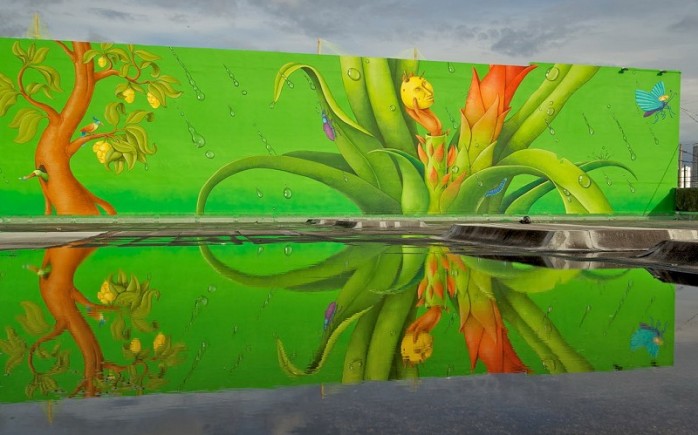
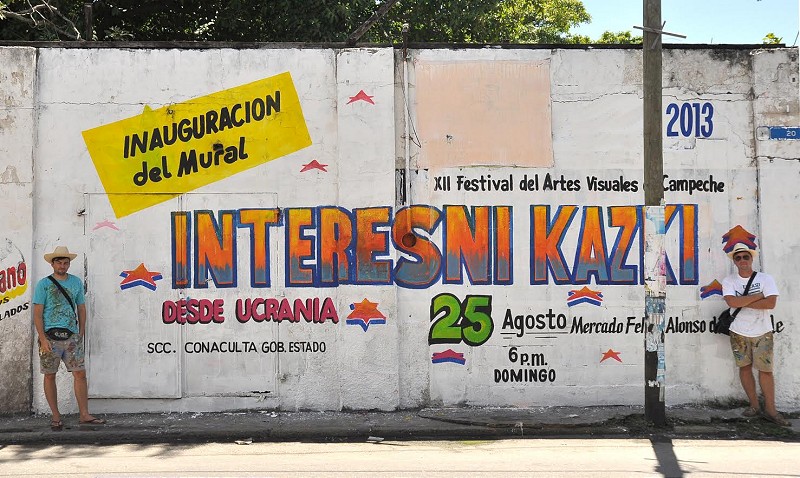 AM: Since when do you remember having interest in art, and when/why did you start painting in the street?
Waone: I have interest in art since I was I child, 4-5 years old. My father had interest in art and he collected Ukrainian art and rare icons. I started to paint graffiti when I found out about it at the end of 90s. I was impressed and started to try to do something like that immediately.
AM: When did you and Aleksei meet and how did you begin such a close collaboration?
Waone: We met in 1999 in a strange place. The place was where people who were interested in graffiti were meeting, talking, drawing sketches, etc.
AM: Do either of you have any formal education as artists?
Waone: I don't have any artistic education. But, I took some drawing and painting classes in my childhood. Most of my education comes from practice and feeling out how to do or not to do.
AM: Since when do you remember having interest in art, and when/why did you start painting in the street?
Waone: I have interest in art since I was I child, 4-5 years old. My father had interest in art and he collected Ukrainian art and rare icons. I started to paint graffiti when I found out about it at the end of 90s. I was impressed and started to try to do something like that immediately.
AM: When did you and Aleksei meet and how did you begin such a close collaboration?
Waone: We met in 1999 in a strange place. The place was where people who were interested in graffiti were meeting, talking, drawing sketches, etc.
AM: Do either of you have any formal education as artists?
Waone: I don't have any artistic education. But, I took some drawing and painting classes in my childhood. Most of my education comes from practice and feeling out how to do or not to do.
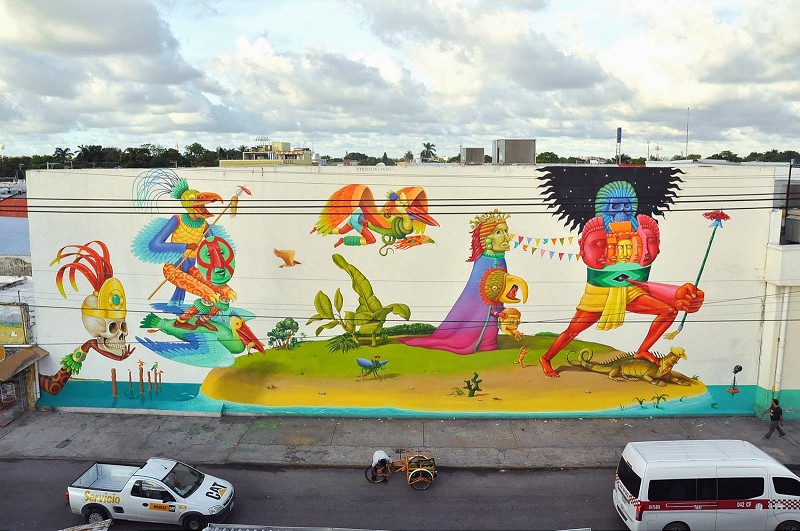 AM: I read in another interview that you two were actively doing graffiti before starting to paint murals. What made you switch to that and when did you the murals?
Waone: Yes, we were actively painting traditional letter graffiti for 3-4 years. "Hip-hop graffiti" means to paint letters and characters, and we painted both. Once we saw another type of graffiti, not traditional "hip-hop American stuff" (it was stuff from Brazil), we discovered for ourselves new horizons. We tried to paint walls without letters and liked it very much. So that time was the origin of our style. It was 2002-2003. In 2005, when the style was formed, we appeared under the name Interesni Kazki.
AM: What do you see as pros and cons about being an artist duo like Interesni Kazki?
Waone: It happens hardly ever that two artists work together. The main plus of working in a duo is the study. It's a big and fast progress. The minus of being an artist in duo is dependence on each other.
AEC: When we work together, it can give a more unexpected result of the whole finished work. Sometimes it's great but sometimes not, especially if one of us had an idea of the whole mural that was changed or became unclear when mural was done. In this case, I can say that painting together is more improvisation, more freestyle, even if we are trying to discuss sketches and work before starting. It's good to take breaks in collaborations, because each of us is an independent person with our own look to the way of creation and philosophy.
AM: What are your thoughts of the work of other duos such as How & Nosm or Os Gemeos?
AEC: I like the works of the guys you mentioned.
Waone: I respect them. I can't say that I like their work too much, though we have been influenced by Os Gemeos works in the past. But now, I think they stopped their progress. Unfortunately it happens with most of artists, when they became famous and rich.
AM: I read in another interview that you two were actively doing graffiti before starting to paint murals. What made you switch to that and when did you the murals?
Waone: Yes, we were actively painting traditional letter graffiti for 3-4 years. "Hip-hop graffiti" means to paint letters and characters, and we painted both. Once we saw another type of graffiti, not traditional "hip-hop American stuff" (it was stuff from Brazil), we discovered for ourselves new horizons. We tried to paint walls without letters and liked it very much. So that time was the origin of our style. It was 2002-2003. In 2005, when the style was formed, we appeared under the name Interesni Kazki.
AM: What do you see as pros and cons about being an artist duo like Interesni Kazki?
Waone: It happens hardly ever that two artists work together. The main plus of working in a duo is the study. It's a big and fast progress. The minus of being an artist in duo is dependence on each other.
AEC: When we work together, it can give a more unexpected result of the whole finished work. Sometimes it's great but sometimes not, especially if one of us had an idea of the whole mural that was changed or became unclear when mural was done. In this case, I can say that painting together is more improvisation, more freestyle, even if we are trying to discuss sketches and work before starting. It's good to take breaks in collaborations, because each of us is an independent person with our own look to the way of creation and philosophy.
AM: What are your thoughts of the work of other duos such as How & Nosm or Os Gemeos?
AEC: I like the works of the guys you mentioned.
Waone: I respect them. I can't say that I like their work too much, though we have been influenced by Os Gemeos works in the past. But now, I think they stopped their progress. Unfortunately it happens with most of artists, when they became famous and rich.
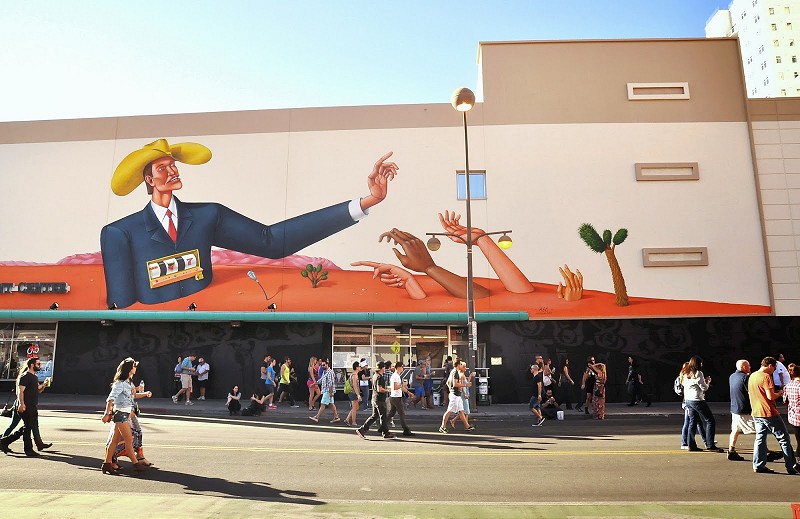 AM: I read somewhere that your work feels like an Eastern European version of Os Gemeos. How do you feel about being compared to them?
Waone: Many people think that we work in a similar style as Os Gemeos. Some people says that we are similar to Salvador Dali or Hieronimus Bosch. For me, it doesn't matter. I respect all of them and take people's comparisons as a compliment.
AEC: Sometimes, I hear these comparisons of us and other artists, but I don't care much about it. It's normal and a lot of artists have some similar ideas or some kind of "universal" ideas or similar styles. Even me and my colleague Vladimir are working a bit different if you're looking at it closely. But at the first glance it all seems the same.
AM: You and Aleksei are both making your own works which is not typical for other collaborating duos. What is your philosophy behind doing separate works?
Waone: Our philosophy is very simple - to give each other freedom.
AEC: As I said before - each of us has our own view on life and own philosophy. For me, to work separately is the way to search for something different than our collaborative creations. Then, this experience can come in handy in our future collaboration because we always have to put something fresh in our collaborations or it can all collapse.
AM: I read somewhere that your work feels like an Eastern European version of Os Gemeos. How do you feel about being compared to them?
Waone: Many people think that we work in a similar style as Os Gemeos. Some people says that we are similar to Salvador Dali or Hieronimus Bosch. For me, it doesn't matter. I respect all of them and take people's comparisons as a compliment.
AEC: Sometimes, I hear these comparisons of us and other artists, but I don't care much about it. It's normal and a lot of artists have some similar ideas or some kind of "universal" ideas or similar styles. Even me and my colleague Vladimir are working a bit different if you're looking at it closely. But at the first glance it all seems the same.
AM: You and Aleksei are both making your own works which is not typical for other collaborating duos. What is your philosophy behind doing separate works?
Waone: Our philosophy is very simple - to give each other freedom.
AEC: As I said before - each of us has our own view on life and own philosophy. For me, to work separately is the way to search for something different than our collaborative creations. Then, this experience can come in handy in our future collaboration because we always have to put something fresh in our collaborations or it can all collapse.
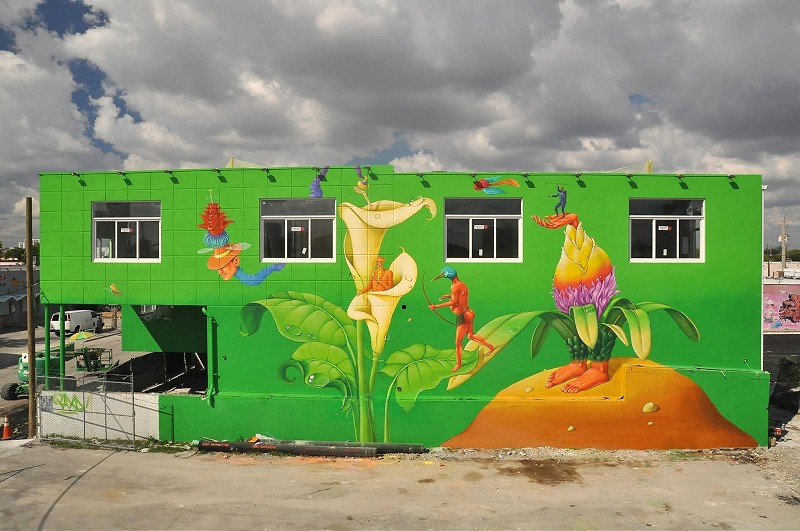 AM: You guys are traveling all over the world to paint. Do you try to create works that fit to the culture/surroundings you are painting in, and how do you work on that?
Waone: Sure, we do it almost every time. The thing is, when you come to any place, you get strong impression from local culture. So then you put all these impressions into the work. You are like a prism, subsuming all the local culture manifestations in your mind, than aggregating all that stuff into a masterpiece. It seems like the local spirit comes into your mind and comes out through your hands, paint, and brushes into the mural.
AEC: Surroundings can sometimes have impressive, bright elements, or nice cultural heritage, and sometimes strange and bad elements. These feelings will influence the inspiration.
AM: How long was your last trip in total, and how many murals did you create?
Waone: The travel took almost three months. In Ciudad del Carmen, Campeche Mexico we spent three weeks and were painting big mural during the two weeks. Then one week in Detroit. Than 1.5 months for a huge building in Wynwood, Miami. In total, we created two murals in Ciudad del Carmen and Detroit, three walls on the Wynwood House in the Wynwood district in Miami together with Alexei, and one big wall I did alone on the same building on Wynwood.
AEC: Yes, I just came back from that trip. In Cuidad del Carmen (Mexico), Detroit, and Miami, we painted together, but I also painted alone in Puerto Rico and Las Vegas. The whole trip took three months for me, and I feel a bit tired but happy.
AM: You guys are traveling all over the world to paint. Do you try to create works that fit to the culture/surroundings you are painting in, and how do you work on that?
Waone: Sure, we do it almost every time. The thing is, when you come to any place, you get strong impression from local culture. So then you put all these impressions into the work. You are like a prism, subsuming all the local culture manifestations in your mind, than aggregating all that stuff into a masterpiece. It seems like the local spirit comes into your mind and comes out through your hands, paint, and brushes into the mural.
AEC: Surroundings can sometimes have impressive, bright elements, or nice cultural heritage, and sometimes strange and bad elements. These feelings will influence the inspiration.
AM: How long was your last trip in total, and how many murals did you create?
Waone: The travel took almost three months. In Ciudad del Carmen, Campeche Mexico we spent three weeks and were painting big mural during the two weeks. Then one week in Detroit. Than 1.5 months for a huge building in Wynwood, Miami. In total, we created two murals in Ciudad del Carmen and Detroit, three walls on the Wynwood House in the Wynwood district in Miami together with Alexei, and one big wall I did alone on the same building on Wynwood.
AEC: Yes, I just came back from that trip. In Cuidad del Carmen (Mexico), Detroit, and Miami, we painted together, but I also painted alone in Puerto Rico and Las Vegas. The whole trip took three months for me, and I feel a bit tired but happy.
 AM: Your new Miami mural is pretty huge. How long did you work on that one?
Waone: For all four sides of that building, we spent 42 days in total.
AEC: Total time of painting in Miami was approximately 3-4 weeks, but a lot of time was wasted on not so good organization or waiting for the rain to stop. So, in total it was 34 days for me and Vladimir spent some more time in doing this wall. He also needed to stay longer because of private reasons. The amount of work was huge because we needed to paint all four walls of the building.
AM: How big is the wall and who helped you organize it?
Waone: The area of that building was more than 1000 sq meters. The organizers was the owner the building, Goldman Properties, and our assistant was Jel Martinez, a local artist.
AM: Did you create any canvas/paper works during this trip?
AEC: No, we didn't work on canvases or drawings during the trip, only sketches for murals that we worked on.
AM: Your new Miami mural is pretty huge. How long did you work on that one?
Waone: For all four sides of that building, we spent 42 days in total.
AEC: Total time of painting in Miami was approximately 3-4 weeks, but a lot of time was wasted on not so good organization or waiting for the rain to stop. So, in total it was 34 days for me and Vladimir spent some more time in doing this wall. He also needed to stay longer because of private reasons. The amount of work was huge because we needed to paint all four walls of the building.
AM: How big is the wall and who helped you organize it?
Waone: The area of that building was more than 1000 sq meters. The organizers was the owner the building, Goldman Properties, and our assistant was Jel Martinez, a local artist.
AM: Did you create any canvas/paper works during this trip?
AEC: No, we didn't work on canvases or drawings during the trip, only sketches for murals that we worked on.
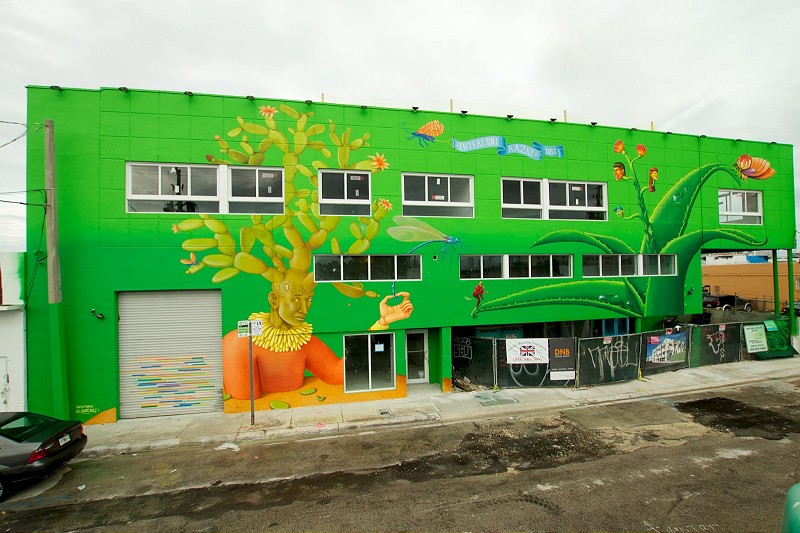 AM: Who should people contact about your canvases and works on paper?
Waone: You can contact us directly, just write an email (waone_ik@yahoo.com), or write to our representative in NYC to gf@madeyoufamous.com (Gregory). Some pieces and prints will be available soon on Underdogs too.
AM: What was the most favorite place you have visited!
AEC: My favorite place from this trip was Puerto Rico for the Los Muros Hablan Festival. Thanks to my friend Alexis Diaz for inviting me!
Waone: I like many places. Can't pick out one of them. I like Mexico, but don't like their non-vegetarian food . I like the Azores Islands - amazing nature. I like India for their rich ancient culture, beautiful nature, and veggie food culture. I've just remembered about the Himalaya Mountains - it was fantastic. I think that place is my favorite.
AM: Is there a certain place in the world that you would like to paint, and why is that?
Waone: Every place becomes boring after spending some time there. It was great to paint in the US because of the perfect tools, very good paints, and huge art industry for example, but the US is the last place where I want to stay. The perfect place to stay and paint for me are the Himalaya Mountains. It's just my favorite place, it's really out of this world, it's another dimension. But the thing is that we came into this world not to rest in our favorite places.
AEC: I want to visit and paint in the countries of South America - Argentina, Peru, Chile, Ecuador, Brasil.
AM: Who should people contact about your canvases and works on paper?
Waone: You can contact us directly, just write an email (waone_ik@yahoo.com), or write to our representative in NYC to gf@madeyoufamous.com (Gregory). Some pieces and prints will be available soon on Underdogs too.
AM: What was the most favorite place you have visited!
AEC: My favorite place from this trip was Puerto Rico for the Los Muros Hablan Festival. Thanks to my friend Alexis Diaz for inviting me!
Waone: I like many places. Can't pick out one of them. I like Mexico, but don't like their non-vegetarian food . I like the Azores Islands - amazing nature. I like India for their rich ancient culture, beautiful nature, and veggie food culture. I've just remembered about the Himalaya Mountains - it was fantastic. I think that place is my favorite.
AM: Is there a certain place in the world that you would like to paint, and why is that?
Waone: Every place becomes boring after spending some time there. It was great to paint in the US because of the perfect tools, very good paints, and huge art industry for example, but the US is the last place where I want to stay. The perfect place to stay and paint for me are the Himalaya Mountains. It's just my favorite place, it's really out of this world, it's another dimension. But the thing is that we came into this world not to rest in our favorite places.
AEC: I want to visit and paint in the countries of South America - Argentina, Peru, Chile, Ecuador, Brasil.
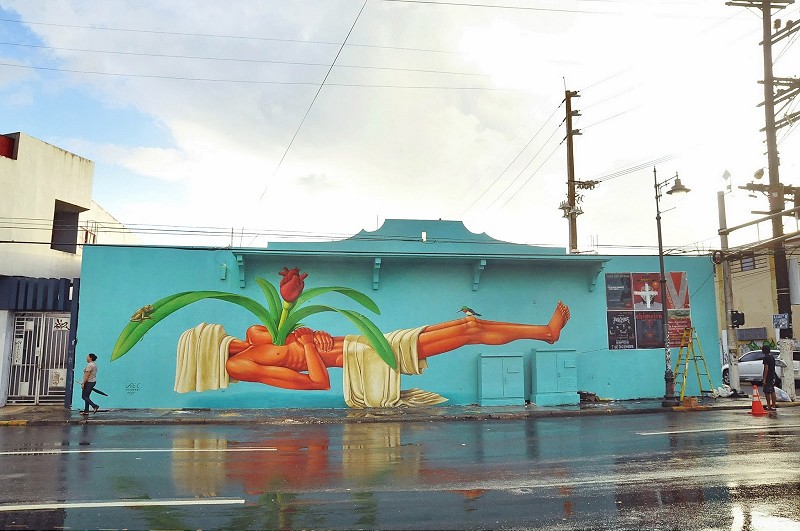 AM: What are your influences, and how do you feel about your work being compared to Dali and surrealists?
AEC: As I said, I don't really care about being compared to another artists especially if these comparisons are to huge and famous artists like Dali or Bosch. I think if somebody compares us to a very famous artist, it shows that this person knows very few artists (and only famous ones), or don't understand things completely. But also, it can be a compliment for us. I don’t think that our works are considered surrealism. It's more like some kind of symbolic metaphorism.
Waone: All the artists have influences. Artists grow up in his technique and as a person, so his interests are changing too. In childhood, I was influenced by children's books as well as scientific and fairy tale illustrations. Sure, I was inspired by Salvador Dali too, because my father had a book about him. When I started to paint graffiti, I was influenced by American "hip hop graffiti." Later, it was brazilian graffiti and Latin American muralists, drawings and book illustrations by Ivan Bilibin, Moebius etc. Now, I am passionate about naturalism - antique prints and mystic medieval engravings. I think we are a bit like Surrealists. As for me, Surrealism is a world view, like next level perception of the world, out of the normal physical senses. Surrealism is a kind of reality, imagined with symbols. It's like a dream, when subconscious or sometimes the "Higher Mind" tells you, through the images, symbols and colors, something very important about real life.
AM: I noticed that most of your murals all done with acrylic. Do you ever use other mediums for creating your work?
AEC: Yes, last year we worked on murals with acrylic only. I started to work with acrylic only in Mexico in May last year, and didn't feel like using spray ever since. Using brushes, rollers and acrylic gives more opportunities for creation and makes free from technologies. Also, it's not so bad your own health compared to the sprays that we used a lot of in the past.
AM: What are your influences, and how do you feel about your work being compared to Dali and surrealists?
AEC: As I said, I don't really care about being compared to another artists especially if these comparisons are to huge and famous artists like Dali or Bosch. I think if somebody compares us to a very famous artist, it shows that this person knows very few artists (and only famous ones), or don't understand things completely. But also, it can be a compliment for us. I don’t think that our works are considered surrealism. It's more like some kind of symbolic metaphorism.
Waone: All the artists have influences. Artists grow up in his technique and as a person, so his interests are changing too. In childhood, I was influenced by children's books as well as scientific and fairy tale illustrations. Sure, I was inspired by Salvador Dali too, because my father had a book about him. When I started to paint graffiti, I was influenced by American "hip hop graffiti." Later, it was brazilian graffiti and Latin American muralists, drawings and book illustrations by Ivan Bilibin, Moebius etc. Now, I am passionate about naturalism - antique prints and mystic medieval engravings. I think we are a bit like Surrealists. As for me, Surrealism is a world view, like next level perception of the world, out of the normal physical senses. Surrealism is a kind of reality, imagined with symbols. It's like a dream, when subconscious or sometimes the "Higher Mind" tells you, through the images, symbols and colors, something very important about real life.
AM: I noticed that most of your murals all done with acrylic. Do you ever use other mediums for creating your work?
AEC: Yes, last year we worked on murals with acrylic only. I started to work with acrylic only in Mexico in May last year, and didn't feel like using spray ever since. Using brushes, rollers and acrylic gives more opportunities for creation and makes free from technologies. Also, it's not so bad your own health compared to the sprays that we used a lot of in the past.
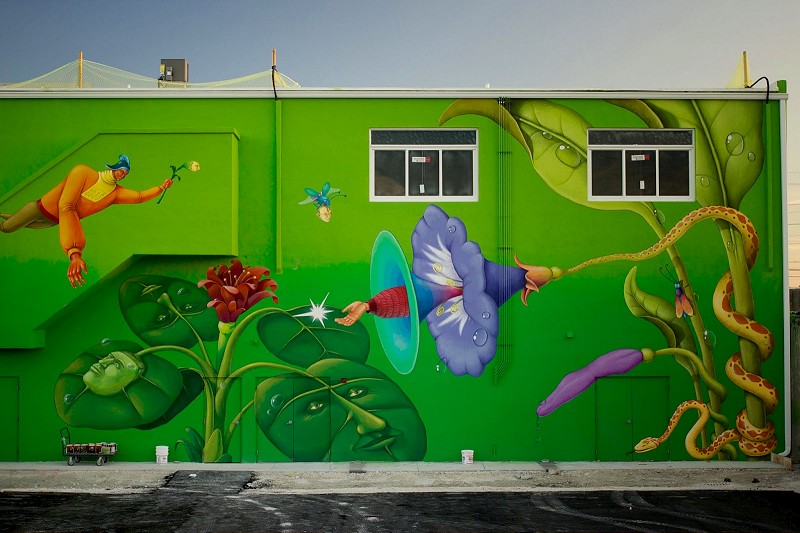 AM: How different is it making smaller, gallery pieces compared to public murals?
Waone: It's totally different genres of art, but art is also the same in a way - same ideas, same feelings. I mean, when you paint, the stream of energy is flowing through your mind, and it doesn't matter if it is on wall or on canvas at all. This is the thing - street or gallery is secondary.
AEC: In the physical aspect, we spend less energy for creating studio works but not less time, but actually even more. For example - a huge wall can be done in 10 days, but a detailed drawing of 80x60cm size can take two weeks.
AM: Which one of the two would you say you prefer, and why?
AEC: Both are interesting for me and I love both. Traveling and painting murals gives a feeling of freedom and the experience creates a lot of emotions that gives a lot of inspiration. Later on, this inspiration can last for studio work too. Each of these two are connected and complement each other.
Waone: I prefer both.
AM: I saw a lot of locals closely following your work as you were creating the mural in Croatia (covered). Do you find it a pressure or a challenge to be watched so closely while you create?
AEC: It depend on the place and country we are working in. For example, when I painted in Moscow I felt pressure from people who passed by and stopped to say something - often something bad. But when I painted in India or in Mexico, I felt comfortable when local people talked to me on the street while painting.
Waone: Yes, sometimes locals disturb us, thats why we put up the barrier tape.
AM: How different is it making smaller, gallery pieces compared to public murals?
Waone: It's totally different genres of art, but art is also the same in a way - same ideas, same feelings. I mean, when you paint, the stream of energy is flowing through your mind, and it doesn't matter if it is on wall or on canvas at all. This is the thing - street or gallery is secondary.
AEC: In the physical aspect, we spend less energy for creating studio works but not less time, but actually even more. For example - a huge wall can be done in 10 days, but a detailed drawing of 80x60cm size can take two weeks.
AM: Which one of the two would you say you prefer, and why?
AEC: Both are interesting for me and I love both. Traveling and painting murals gives a feeling of freedom and the experience creates a lot of emotions that gives a lot of inspiration. Later on, this inspiration can last for studio work too. Each of these two are connected and complement each other.
Waone: I prefer both.
AM: I saw a lot of locals closely following your work as you were creating the mural in Croatia (covered). Do you find it a pressure or a challenge to be watched so closely while you create?
AEC: It depend on the place and country we are working in. For example, when I painted in Moscow I felt pressure from people who passed by and stopped to say something - often something bad. But when I painted in India or in Mexico, I felt comfortable when local people talked to me on the street while painting.
Waone: Yes, sometimes locals disturb us, thats why we put up the barrier tape.
 AM: How many gallery shows did you have so far, and how did you feel about having your work exhibited in a gallery?
Waone: We had three solo shows and too many group shows. It's good promotion.
AEC: I feel ok to do a gallery show, but lately we were more focused on mural projects.
AM: A few months ago you had your first print release with Underdogs. How did you like working on that, and could you tell us a bit about the images you picked?
Waone: We likde that. It was a good experience. And, we will continue to work with them on prints. I don't know what to say about the picked images. We picked it together with Underdogs. My piece that we picked for print is Triad - it's about the nature of the universe.
AEC: We enjoy the result - two digital prints of our recent canvases. But, the next release will be even better because it will be a screenprint with hand finishing in a very limited edition.
AM: In another interview, you mentioned the street art scene in Ukraine is not that big. Do you think your work is making it more popular, and do people in Ukraine know much about it?
Waone: Yes, the street art scene (not graffiti scene) in Ukraine is not big, and unfortunately there is no progress on it. Currently, there are bad conditions not only for street art but for life in general. People have to think how to survive, for them it's - "What street art are you talking about"?
AEC: I don't want to use the term "street art scene" because this seems like some kind of fashion statement. We have some very good artists in Ukraine, that sometime work on the street too. Yes, our works probably created more interest in art in the street, but we almost have not worked at all in public spaces in Ukraine in the last two years because of all the traveling and working on projects around the world. Ukrainians can see our new works only on the internet.
AM: How many gallery shows did you have so far, and how did you feel about having your work exhibited in a gallery?
Waone: We had three solo shows and too many group shows. It's good promotion.
AEC: I feel ok to do a gallery show, but lately we were more focused on mural projects.
AM: A few months ago you had your first print release with Underdogs. How did you like working on that, and could you tell us a bit about the images you picked?
Waone: We likde that. It was a good experience. And, we will continue to work with them on prints. I don't know what to say about the picked images. We picked it together with Underdogs. My piece that we picked for print is Triad - it's about the nature of the universe.
AEC: We enjoy the result - two digital prints of our recent canvases. But, the next release will be even better because it will be a screenprint with hand finishing in a very limited edition.
AM: In another interview, you mentioned the street art scene in Ukraine is not that big. Do you think your work is making it more popular, and do people in Ukraine know much about it?
Waone: Yes, the street art scene (not graffiti scene) in Ukraine is not big, and unfortunately there is no progress on it. Currently, there are bad conditions not only for street art but for life in general. People have to think how to survive, for them it's - "What street art are you talking about"?
AEC: I don't want to use the term "street art scene" because this seems like some kind of fashion statement. We have some very good artists in Ukraine, that sometime work on the street too. Yes, our works probably created more interest in art in the street, but we almost have not worked at all in public spaces in Ukraine in the last two years because of all the traveling and working on projects around the world. Ukrainians can see our new works only on the internet.
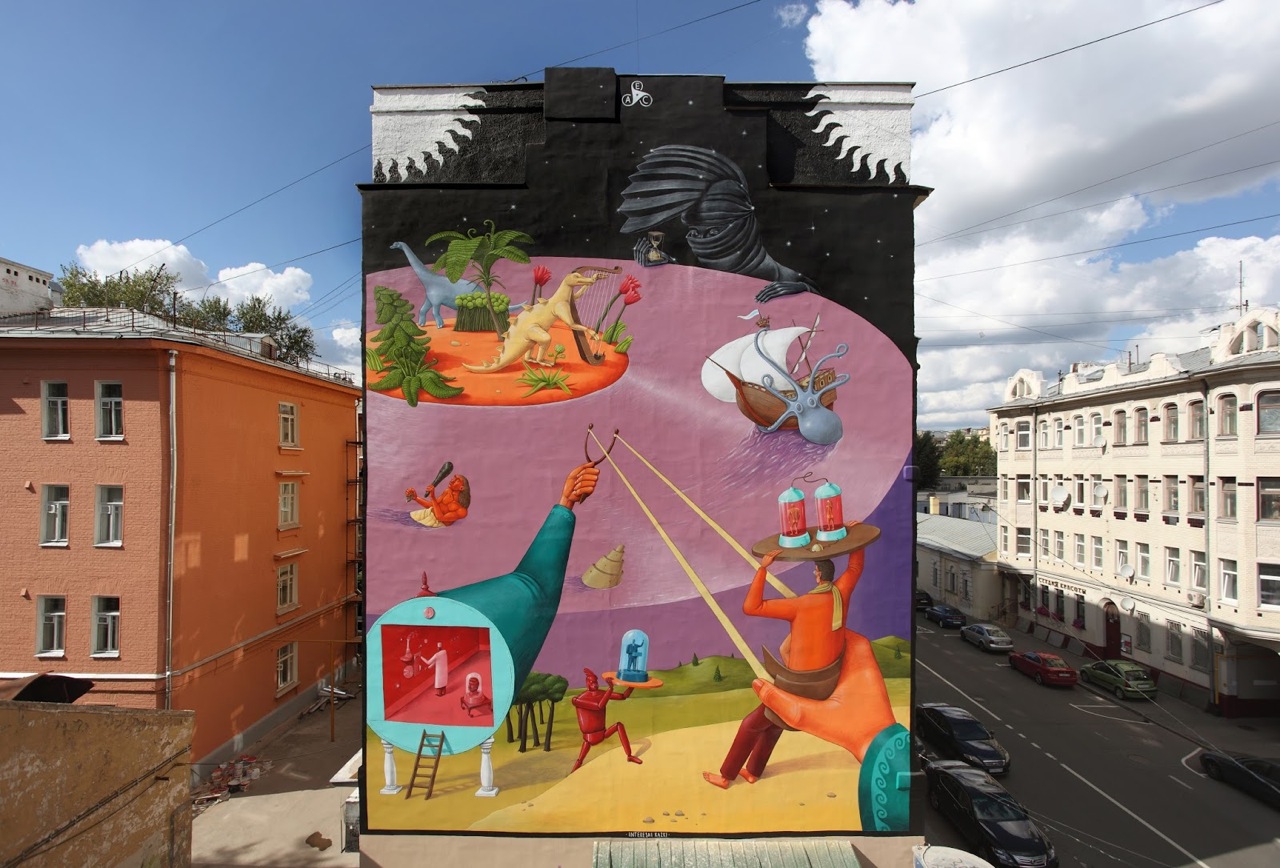 AM: How often do you paint back in Kiev, and what would you like to see happen to the art scene back there?
Waone: We used to paint a lot. We found an opportunity to paint as much as we could. The art scene can't change just because some powerful forces are interested in keeping it in this way - the way of human degradation. Not only in art scene, but nothing can change for the better when the worst people of society lead the country.
AEC: There was a time when we were trying to organize some mural projects in Ukraine, but we faced the wall of bureaucracy, difficulty in obtaining permits, and the inability to find financing. So, we decided not to waste our time and chose to participate in international mural projects to which we are often invited. But, we have not abandoned hope of success in this matter in Ukraine.
AM: How do you feel about your work being shared on the Internet so quick after it's finished, and do you like the way that is affecting the whole street art scene?
Waone: Sometimes, I think that it's nothing special and I don't care - I just care about doing my best.
AEC: I don't enjoy when work gets to the Internet very fast especially if it's not finished, or is of bad quality in terms of image / colors, or without my approval. But, I can't influence that because it's art in a public space. And, I don’t care much about the term "street art scene." Actually, I want to say something about it - There is tendency for a wave of popularity of street art in the world nowadays. Because of this, things that are made on the street often get more attention, respect, and are discussed by more people. As a result, they become more valuable than art that wasn't made on the street, but in reality, it is much more important and valuable. That is why I prefer to work with acrylic and brushes, more slowly, but with more quality, and try to use more diverse topics, imagery and details.
AM: How often do you paint back in Kiev, and what would you like to see happen to the art scene back there?
Waone: We used to paint a lot. We found an opportunity to paint as much as we could. The art scene can't change just because some powerful forces are interested in keeping it in this way - the way of human degradation. Not only in art scene, but nothing can change for the better when the worst people of society lead the country.
AEC: There was a time when we were trying to organize some mural projects in Ukraine, but we faced the wall of bureaucracy, difficulty in obtaining permits, and the inability to find financing. So, we decided not to waste our time and chose to participate in international mural projects to which we are often invited. But, we have not abandoned hope of success in this matter in Ukraine.
AM: How do you feel about your work being shared on the Internet so quick after it's finished, and do you like the way that is affecting the whole street art scene?
Waone: Sometimes, I think that it's nothing special and I don't care - I just care about doing my best.
AEC: I don't enjoy when work gets to the Internet very fast especially if it's not finished, or is of bad quality in terms of image / colors, or without my approval. But, I can't influence that because it's art in a public space. And, I don’t care much about the term "street art scene." Actually, I want to say something about it - There is tendency for a wave of popularity of street art in the world nowadays. Because of this, things that are made on the street often get more attention, respect, and are discussed by more people. As a result, they become more valuable than art that wasn't made on the street, but in reality, it is much more important and valuable. That is why I prefer to work with acrylic and brushes, more slowly, but with more quality, and try to use more diverse topics, imagery and details.
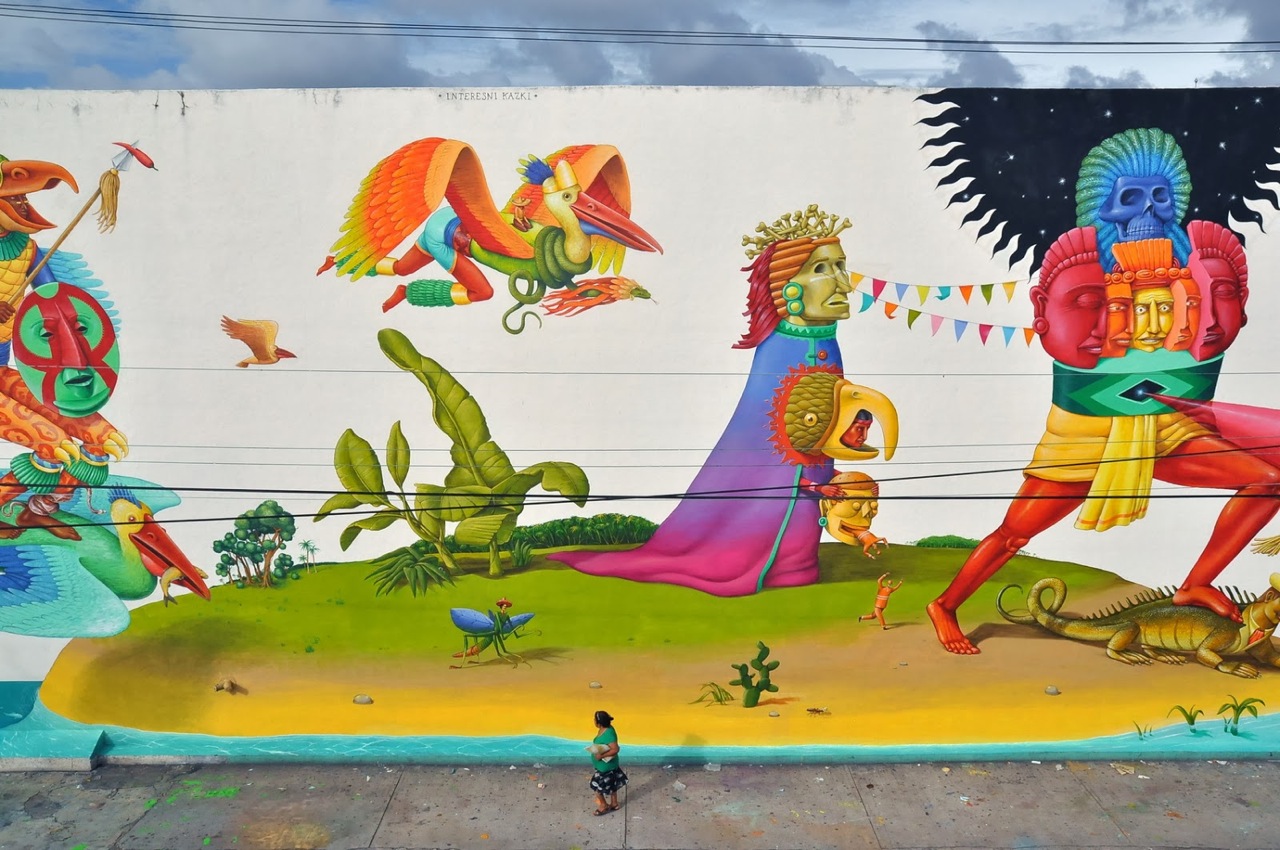 AM: Do you read articles or forum posts about your works and how do you feel about it?
AEC: Yes, sometime I see some nice text about our works and it can be interesting to read what people see in our works and how they understand it.
Waone: No, I don't. I don't have enough time for that. There are many other, more useful stuff to read.
AM: What are the major career goals for you two?
Waone: Five years ago, my goal was to travel and paint all over the world. Now I travel all over the world and paint. The last few years, we worked so hard and so often that I asked myself - do I need this? But each time after we finish, I see the viewers' reactions, how much they like what I do, and the big influence my work has in a good way. Then I understood - they need this. So my goal is just to do my best - this is the way to perfection. Perfection in art leads me to personal perfection, and this evolution. So the goal is evolution.
AEC: I think our painting is not a career but a way of life - the way to find reason in life and our own mission on Earth.
AM: Can you share with us what you have scheduled in the future? Any gallery shows or big projects planned?
AEC: We are taking part in group show in Lisbon with Underdogs this December, and in a group show in Miami during Art Basel with Greg Shienbaum.
Waone: We are also going to make new releases of prints with Underdogs and The Outsiders. These will be silkscreen hand-finished prints, and we're planning a solo show in May 2014 with Studiocromie.
Discuss Interesni Kazki here.
AM: Do you read articles or forum posts about your works and how do you feel about it?
AEC: Yes, sometime I see some nice text about our works and it can be interesting to read what people see in our works and how they understand it.
Waone: No, I don't. I don't have enough time for that. There are many other, more useful stuff to read.
AM: What are the major career goals for you two?
Waone: Five years ago, my goal was to travel and paint all over the world. Now I travel all over the world and paint. The last few years, we worked so hard and so often that I asked myself - do I need this? But each time after we finish, I see the viewers' reactions, how much they like what I do, and the big influence my work has in a good way. Then I understood - they need this. So my goal is just to do my best - this is the way to perfection. Perfection in art leads me to personal perfection, and this evolution. So the goal is evolution.
AEC: I think our painting is not a career but a way of life - the way to find reason in life and our own mission on Earth.
AM: Can you share with us what you have scheduled in the future? Any gallery shows or big projects planned?
AEC: We are taking part in group show in Lisbon with Underdogs this December, and in a group show in Miami during Art Basel with Greg Shienbaum.
Waone: We are also going to make new releases of prints with Underdogs and The Outsiders. These will be silkscreen hand-finished prints, and we're planning a solo show in May 2014 with Studiocromie.
Discuss Interesni Kazki here.